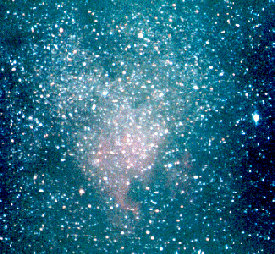 ...
... 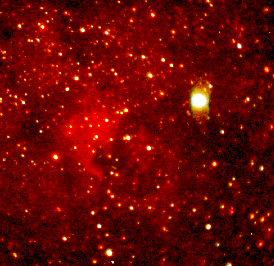
North America Nebula (bright Deneb is at right) .
ISM - Birth - Main Sequence - Red Giant - Death - Nova - Appendix
Look at the Evolution of star clusters at the University of Oregon !
The perfect vacuum!!
That's correct - if you asked those physicists who are working with vacuum equipment everyday. The best vacuum they achieve, is probably about a billion particles per cubic inch (as compared to a quadrillion particles in normal air). Good enough for them - but see how good the vacuum is aboard the Space Shuttle (and why they want to participate): ...
... the astrophysicist is working with (actually
s/he merely observes it): between 0.00001 and 10,000 particles
per cubic inch! Not a perfect, absolutely empty vacuum, but
certainly the envy of these experimental physicists.
A millionth of the amount of the best vacuum on Earth - hardly any particles around. And that should matter?
Why should it matter? Let's forget about it.
However, space is huuuuuuuuuuuuuuuuuuuuuuuge: Although the density is low, the volume is huge, and therefore the mass it constitutes of is large as well.
So, it does matter.
What is it?
 ...
... 
Gas and Dust.
Hydrogen, some Helium, and aggregates of molecules composed of metals
(dust).
There are gas clouds that absorb light (Hydrogen
lines) from stars (Arny p.451ff; Ch/Mc p.307;
Pasa p.502). 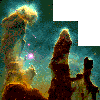
The Eagle nebula in Serpens, stars are born here, (c) AURA / STScI
. There are emission nebulae, heated by
a near-by young star, hot enough to produce an emission spectrum. And
there are dark dust clouds, virtually absorbing all radiation. That's
why we can't see the center of our Milky Way Galaxy (Arny
p.453; Ch/Mc p.404; Pasa p.505).
What are they important for?
Once upon a time ... there was nothing in the universe but gas and dust - no stars. Then - all the sudden? - stars appeared. How come?
Back up: stars consist of Hydrogen and Helium. Notice something?
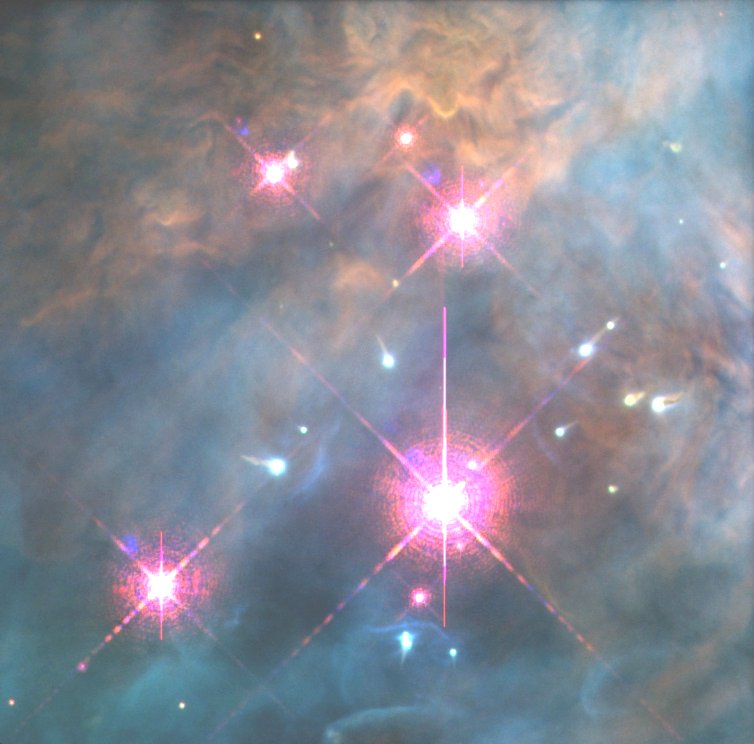 The Trapezium in the Orion
Nebula, another region of starbirth, (c) AURA / STScI .
The interstellar medium consists of Hydrogen and Helium as well.
The Trapezium in the Orion
Nebula, another region of starbirth, (c) AURA / STScI .
The interstellar medium consists of Hydrogen and Helium as well.
It is the birthplace for stars!!
A gas cloud is the beginning of a star's evolution.
That's correct.
Does a gas cloud have enough mass to form a star? In fact, it needs a mass equivalent to 1,000 to 10,000 sun masses. Such a cloud has a radius of about 100 light-years.
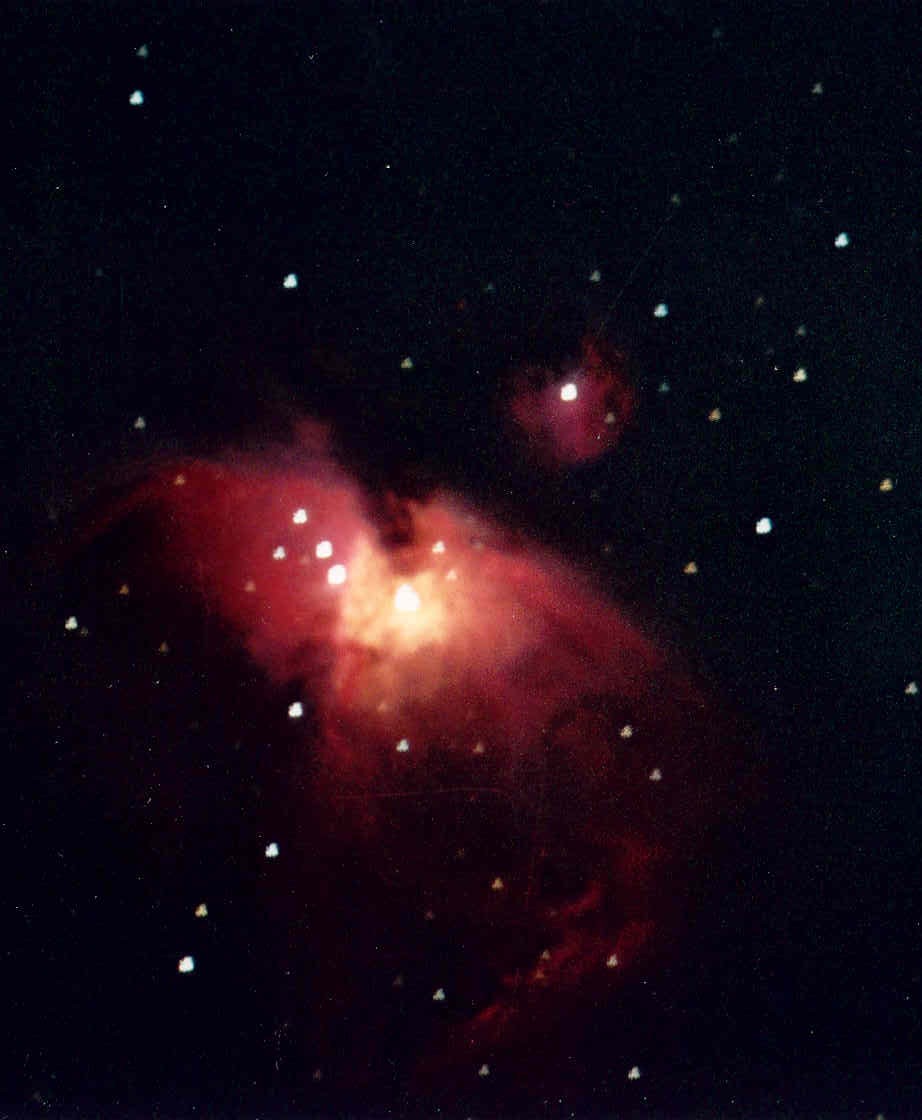 A larger view of the Orion Nebula, (c) Martin Reble
and Sebastian Kupijai., 8"
Cassegrain, 5 minutes, 2-24-03.
What is the main difference between a star and the gas cloud? Think
about
our discussion above and the star's density. ________________
A larger view of the Orion Nebula, (c) Martin Reble
and Sebastian Kupijai., 8"
Cassegrain, 5 minutes, 2-24-03.
What is the main difference between a star and the gas cloud? Think
about
our discussion above and the star's density. ________________
That's correct, too.
How does a low density cloud become a high density star? ____________________
That's correct, tootoo.
Well, how and why can it contract? Well, look at the above, a star's main condition of equilibrium: Most gas clouds are in hydrostatic equilibrium as well. Such a cloud would neither contract nor expand, therefore never form stars (Ch/Mc p.310f).
But, there are some clouds that are either massive enough or were
triggered (e.g. by an exploding star - a supernova)
to contract.
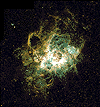 Giant Starbirth Region In
Neighboring Galaxy, (c)
AURA / STScI .
Giant Starbirth Region In
Neighboring Galaxy, (c)
AURA / STScI .
For these clouds, main condition of equilibrium is not fulfilled.
______________ is larger than ___________ and the cloud starts
contracting.
Contract, contract, kontrahier, contract, fragment - oops, lots of
small contracting clouds.
 Proplyds in Orion Nebula, (c) AURA / STScI . Pump
in the gas (e.g. with a bicycle pump - fast - and feel
the nozzle: it's hot). So the temperature increases, and thus
the pressure. But for a long time to come (formation
of a protostar from a gas cloud takes between 1 million and 1 billion
years) it won't be hot enough to match gravity.
Proplyds in Orion Nebula, (c) AURA / STScI . Pump
in the gas (e.g. with a bicycle pump - fast - and feel
the nozzle: it's hot). So the temperature increases, and thus
the pressure. But for a long time to come (formation
of a protostar from a gas cloud takes between 1 million and 1 billion
years) it won't be hot enough to match gravity.
(See Arny p.387; Ch/Mc p.312): the evolution of a solar mass star is discussed - yet, as (Arny Fig. 13.2&3, 13.17&21; Ch/Mc p.315; Pasa p.433) shows, stars of different mass follow the same pattern, although mass (of course) , temperature, luminosity, and time in labor are different.
Eventually a protostar forms, with a definite radius and surface temperature, appearing on the HR-diagram. Look at the luminosity equation in (Arny p.359; Ch/Mc p.281). Although the protostar's surface is ½ as cold as our Sun's, it's radius is 50 times larger: therefore it is much ______________ than our Sun.
Its core is at 1,000,000 Kelvin, still a factor 15 short of igniting nuclear fusion. So where does the energy come from that it radiates?
"The grandest generalization of physics is the conservation of
energy."
Physicists tell us that potential energy decreases as the cloud
contracts. This energy must go somewhere: half of it is radiated into
space, the
other half continues to heat up the protostar.
By the way, the cloud is still contracting. Still, gravity is
stronger than pressure.
More by the way. I'm in Chadron, typing busily, with several people
chatting, and so it's hard to be in a funny mood.
 The Pleiades in Taurus, a
young open cluster, (c) David Malin, AAO . Contract,
heat up, contract, heat up, contract, heat up, ignite Hydrogen,
increase pressure, balance gravity. The main condition is fulfilled and
The Pleiades in Taurus, a
young open cluster, (c) David Malin, AAO . Contract,
heat up, contract, heat up, contract, heat up, ignite Hydrogen,
increase pressure, balance gravity. The main condition is fulfilled and
 Inside Red Dwarfs (Gl752b), (c) AURA / STScI . At
this stage the star will produce as much energy as it
radiates into space. Here, on the Main Sequence, it will stay for
billions
of years (depending on its mass).
Inside Red Dwarfs (Gl752b), (c) AURA / STScI . At
this stage the star will produce as much energy as it
radiates into space. Here, on the Main Sequence, it will stay for
billions
of years (depending on its mass).
How long did it take this new star to form from a gas cloud (check the Appendix )?
Main sequence:
M-stars 0.1 sun masses __________ years
G-stars 1 sun mass __________ years
O-stars 20 sun masses __________ years
So, the more massive a star is, the _______________ it takes
it
to reach the main sequence.
Why? Because it's more massive and therefore gravity is larger, and
therefore it contracts faster.
The opposite of course is true for low massive stars.
 (c) AURA / STScI . What is
the lowest mass for a star? _______ sun masses. ->
(c) AURA / STScI . What is
the lowest mass for a star? _______ sun masses. ->  eventually gravity and pressure are
balanced, but the core temperature is too small to ignite Hydrogen. It
can still give off heat though, just as our 2 biggest planets do -
hundred fold Jupiter's mass and it would have become a star. Such
failed stars are called brown dwarfs (the first
image shows Gliese 229B, the second Brown Dwarf Gliese 229B) , (c) AURA / STScI .
eventually gravity and pressure are
balanced, but the core temperature is too small to ignite Hydrogen. It
can still give off heat though, just as our 2 biggest planets do -
hundred fold Jupiter's mass and it would have become a star. Such
failed stars are called brown dwarfs (the first
image shows Gliese 229B, the second Brown Dwarf Gliese 229B) , (c) AURA / STScI .
What is the highest mass for a star? _________ sun masses.
-> eventually such a massive star would have become hot enough to
drive away the surrounding mass atop its surface, so it won't
accumulate any more
mass.
Summary:
Stars are forming from a contracting gas cloud.
The gas cloud must have sufficient mass (> 1,000
sun masses) or be triggered by an external event.
The cloud continues to contract and to heat up until it finally settles
to be a star, which means that Hydrogen fusion has ignited (15,000,000 Kelvin) and gravity and pressure balance
each other.
There it'll stay on the main sequence.
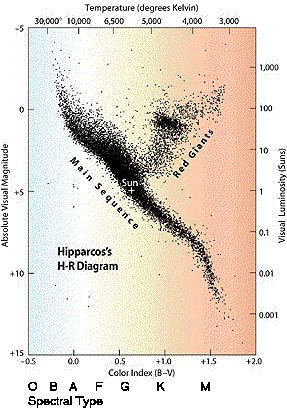 |
HR-diagram of the nearest stars, (c)
Hipparcos, ESA .
Well, it's not much evolving. It's like watching a light bulb for 5 months that steadily glows. Eventually the tungsten will rip apart, the light bulb darkens. It would be exiting if the bulb would then implode. However, for 10 billion years (we're at
half time, so get a hot dog) the sun steadily burns hydrogen,
its core depletes hydrogen slightly and increases its Helium amount.
Due to this slow depletion the sun becomes slightly hotter and
brighter. The main sequence is by far the longest period in a star's life and by far the least eventful. What is the lifetime of a star ( Appendix )? |
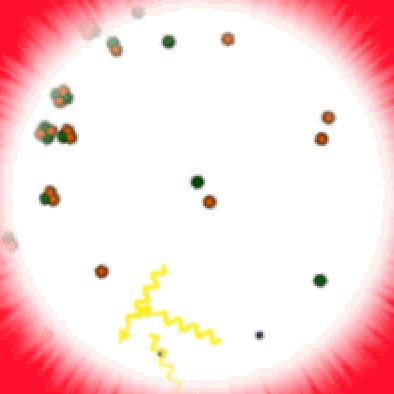 |
Inside the core of a low mass star.
Energy is generated via the proton-proton chain. (c) Redshift 3.
Main sequence: M-stars 0.1 sun masses __________ years |
(see Arny p.396) Vogt-Russell Theorem: "The entire evolution of a star" depends solely on "its initial mass and chemical composition."
Let's care about low-mass stars first (below 5 to 10 sun masses, including our own sun of course; the following development is the same for all low mass stars, just the amount of time it takes would differ according to their mass).
Nuclear fusion in the core depends on temperature, pressure
and
density. Hydrogen fuses into Helium, which is four times as massive as
Hydrogen.
Therefore, Helium sinks to the center. This center keeps growing during
a
star's life.
At the end of its life, too little Hydrogen is left at the center where
it would be hot enough for nuclear fusion -> the chance of Hydrogen
nuclei colliding with each other becomes too small to keep fusion
going.
The hydrogen outside the Helium core is too cold though for fusion.
The star loses its balance. Now that nuclear fusion ceased, what happens ...?
...
That's right! You're fantastic.
The contraction of the star releases gravitational energy,
which radiates away into space. The star's surface temperature
decreases (to about 3000 K, so its color is _______),
but it also grows slightly, which causes its brightness to remain about
the same. -> horizontal line in the HR-diagram.
This whole process, and including the next paragraphs of hydrogen shell
burning, lasts about 100 million years (remember, no
fusion during most of that time).
During that time the Helium core shrinks and heats up, yet not enough to ignite Helium (due to its larger mass and two-fold electric charge it needs 100 mill. K). However, a shell of hydrogen around the core reaches its sufficient 10 mill. K and ignites -> Hydrogen shell burning.
And nuclear fusion returns to the dying star, one of its last breaths. More eventful ones (last breaths) will follow.
The heat from the hydrogen shell increases the size of the star hundred fold, also increasing its brightness dramatically (its surface temperature decreases slightly).
 Betelgeuse, the only
star (other than our Sun) for which it's
possible to image its surface - because it's so big
(size of Earth's orbit) and close enough, (c) AURA / STScI . The
star is cold (red) and huge (gigantic):
A
Betelgeuse, the only
star (other than our Sun) for which it's
possible to image its surface - because it's so big
(size of Earth's orbit) and close enough, (c) AURA / STScI . The
star is cold (red) and huge (gigantic):
A
Red Giant.
More about that next time ...
... stay tuned to read about the Helium Flash, Carbon core (you don't wanna mine that diamond), Planetary Nebula, and White Dwarf.
Now comes one of the hardest part, but judge yourself. It's about electron degeneracy.
The balancing force against gravity is pressure. So far we have said that pressure depends on temperature, applying unconsciously the ideal gas law (pressure ~ temperature). But now that the core is contracting even further, this doesn't hold any more.
How do atoms look like inside a star's core? ____________________________________
We call this Plasma: electrons are stripped off the nuclei (since temperature is so high).
Well, where are the electrons? They are floating around in that thick soup of Hydrogen and Helium nuclei. They are at the same temperature as the nuclei, but they're about 2000-7500 times lighter. Therefore they're much faster.
Something interesting happens: In the Red Giant phase these electrons take responsibility for the pressure (called electron degeneracy) inside the core. Furthermore, this pressure doesn't depend on temperature. The latter means that temperature increases while pressure stays the same.
So throughout all these thousands/millions of years
........while helium accumulates in the core
................due to hydrogen fusing in a shell
........................the core contracts slightly
................................and increases its temperature from 10
mill. K to 100 mill. K
........................................without increasing the core
pressure
................................................that is without any
relief.
Right.
Due to helium fusing
........energy is produced in the core
................temperature goes up
........................but pressure stays the same
(due to electron degeneracy)
................................-> so no relief for the core
I.e. more and more helium fuses and the temperature climbs till
virtually all helium fuses.
Surprise: For a change this doesn't happen on an astronomical time scale, but within seconds!
All Helium fuses almost instantly - the
HELIUM FLASH Gordon
and electron degeneracy is destroyed.
By the way, what do you get when something burns? ______
So Helium fusion produces ________
Let's accelerate our lecture.
For reasons not mentioned the star actually becomes dimmer for a while. Then Helium fuses in a shell (smoothly) while hydrogen fuses in an outer shell, so the star becomes fainter. Now, usually (that is for light enough stars) the Carbon flash doesn't occur.
For more reasons not explained, while the core shrinks, the outer layers of the star (call it atmosphere or envelope) expand.
 ..Expansion -
..Expansion -
.........Cooling -
..............Nuclei and electrons recombine to form atoms.
...................This envelope is pushed away
..........................and forms a so called Planetary Nebula
(Cateye Nebula, (c)
STScI ),
again an unfortunate name because it doesn't have anything to do
with
planets (Arny p.401).
Still heated from its center star (actually only the
carbon core remained) it emits light, primarily of course the
red hydrogen line.

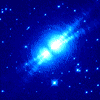
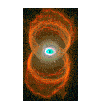
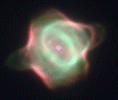
For some spectra of planetary nebulae, look here: John Talbot's Laser Stars pages .
What happens to the core?
It's carbon, which appears as graphite on Earth, so it would be black.
However, its temperature is high and its density is huge (because it's about as small as our earth), so it's rather a diamond.
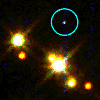 A single white dwarf is
circled in this image, (c)
AURA / STScI . Well, it's a White
Dwarf and it continues to shine white (10,000 K),
but dim (it's small), until all the stored
heat is given off (nuclear fusion isn't going on
anymore). It will do so for billennia and trillennia. When it
eventually becomes cold, it becomes a black dwarf (what
are the chances of detecting one?) and the force that keeps it
from totally imploding is again electron degeneracy.
A single white dwarf is
circled in this image, (c)
AURA / STScI . Well, it's a White
Dwarf and it continues to shine white (10,000 K),
but dim (it's small), until all the stored
heat is given off (nuclear fusion isn't going on
anymore). It will do so for billennia and trillennia. When it
eventually becomes cold, it becomes a black dwarf (what
are the chances of detecting one?) and the force that keeps it
from totally imploding is again electron degeneracy.
In depth: Planetary Nebulae
That's actually a misnomer: when these objects were first discovered
in the 1700's their round, smudgy appearance resembled the appearance
of planets. Nebula stands for haze, cloud, fog.
Since more powerful telescopes (better resolution) and photography were
built and invented since then, their true nature became known: a
stellar atmosphere gently pushed off by its dying star leaving a white
dwarf behind. The non-violent expulsion of gas coupled with a
special immediate environment around the star produces various
intricate structures. The intense UV radiation from the hot white
dwarf heats up the blown off gas and makes it glow in various colors.
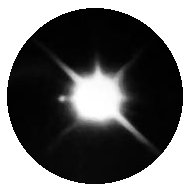
Sirius B & A Its companion, "B", was a heavier MS star, died younger, developed into a RG, and is now a wd. The planetary nebula phase lasts such a short time that it's over by now for B. |
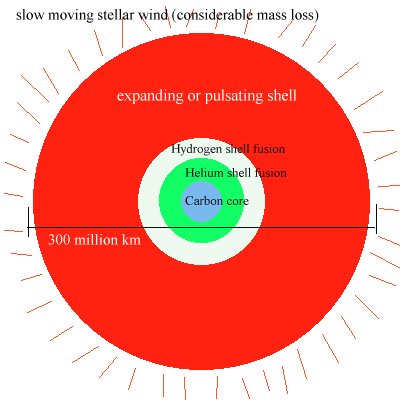
Inside a Red Giant |
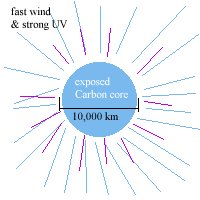 In the transition phase between the RG and white dwarf, a fast wind catches up to the slower gas: this collision produces intricate structures (e.g. Eskimo, Glowing Eye, Helix). The collision heats up the gas, making it glow. In addition, the hot white dwarf emits intense UV radiation, making the ejected gases fluoresce. And visible light from the white dwarf is scattered by the dust.
|
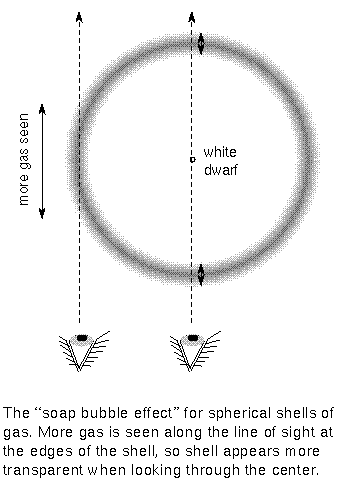 |
 Cat's Eye |
 Eskimo |
 Stingray |
 Egg |
 Hour glass |
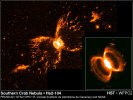 Symbiotic stars |
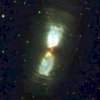 Cotton Candy |
 Butterfly or Twin Jet (VLT at left) ; Left Right |
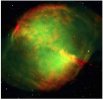
Dumbbell (VLT) |
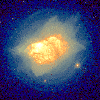 |
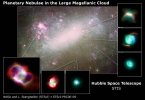 PN's in Large Magellanic Cloud |
|
 Glowing Eye |
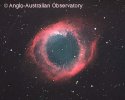  Helix (AAT) |
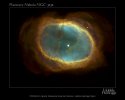
Southern Ring |
  Ring (M. Reble at left); L R |
(Arny p.402) What about high mass stars (> 8 sun masses)?
Note that for the following, stars experience the same formation, Main Sequence and Helium flash as the low mass stars. Simply their way of dying is dramatically different.
Here, temperature in the carbon core is high enough,
.... so Carbon does ignite (combining with Helium)
,
........ forming Oxygen (it's 1 billion K, its density
is 1 mill. times higher than on earth, so it's not breathable)
............ then Oxygen ignites
................ forming Neon (all the while hydrogen,
helium, carbon, etc. are fusing in shells)
.................... and so on, every second element in the periodic
system
........................ until Iron is formed in the core.
Why does it stop with iron? __________________________
Well, nuclear fusion sets energy free, but beginning with Iron nuclear fusion requires energy. The stored heat is not enough to keep iron burning and since iron fusion could not supply the energy need, the chain of element formation must stop here.
In the beginning of the universe, only the lightest elements were formed: 90% Hydrogen, nearly 10% Helium, and traces of Lithium.
We have seen that a star can produce some of the elements between Hydrogen and Iron.
What about the other elements between H and Fe? __________________________________ __________________________________
How did they leave the star? _________________________________________
What about the elements beyond Iron?
________________________________________,
only such an event is powerful enough to fuse elements beyond Iron.
(Arny p.404) So what happens with the non-fusing iron core?
THE MOST DRAMATIC
EVENT IMAGINABLE:
The outer layers are blasted away.
 A supernova detected in a
spiral galaxy, a single (exploding) star
rivaling the brightness of a hundred billion stars in its own
galaxy, (c) AURA / STScI .
This produces so much energy that elements heavier than Iron form (all the way to Uranium) and that the star increases
its luminosity by a factor of 1 billion for several weeks, making a
supernova as bright as its own entire galaxy before it fades almost
into obscurity:
A supernova detected in a
spiral galaxy, a single (exploding) star
rivaling the brightness of a hundred billion stars in its own
galaxy, (c) AURA / STScI .
This produces so much energy that elements heavier than Iron form (all the way to Uranium) and that the star increases
its luminosity by a factor of 1 billion for several weeks, making a
supernova as bright as its own entire galaxy before it fades almost
into obscurity:
The remaining star can be a neutron star, which balances gravity with its own tightly packed neutrons.
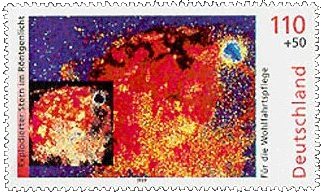 Vela Supernova Remnant in
x-rays, 1999 stamp (c) German Postal Services .
But the expanding outer layers become an irregular
nebula (a supernova remnant) around the neutron
star, which make beautiful photographs.
Vela Supernova Remnant in
x-rays, 1999 stamp (c) German Postal Services .
But the expanding outer layers become an irregular
nebula (a supernova remnant) around the neutron
star, which make beautiful photographs.
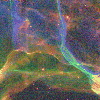
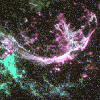
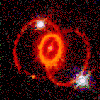
Supernovae in our galaxy close to our sun can outshine all
stars, which happened in
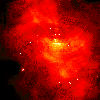 ...1054 (recorded
by the
Chinese ; for an account see the Kopernik
Astronomical Society ), now the Crab Nebula in Taurus, (c) AURA / STScI
...1054 (recorded
by the
Chinese ; for an account see the Kopernik
Astronomical Society ), now the Crab Nebula in Taurus, (c) AURA / STScI
...1572 (recorded by Tycho Brahe)
...1604 (recorded by Johannes Kepler, Galileo Galilei)
They should happen every 300 years in a galaxy, so we're overdue -
maybe it happens during our life time, so watch out!
Earlier we talked about low (0.08 to about 5-10 sun
masses) and high (about 5-10 to more than 20
sun masses) mass stars. Mass is the single most important
property of a star. It determines the evolution of a star as well as
its lifetime (e.g. lower mass stars live longer).
In all the above discussed cases this means the initial mass, which
decreases by less than 1% from birth to onset of a planetary nebula or
a supernova. So mass is fairly constant.
However, mass of a star can drastically change due to 3 reasons:
1. The star is one component of a binary system (remember,
that these are used to determine stellar masses due to Kepler's 3rd)
and it accretes mass from its component, which can happen any time
during the star's lifetime, provided that they are close enough so that
matter can flow from one to the other. How? What happens? See ya later
...
2. The already mentioned planetary nebula (ejection
of star's atmosphere) or supernova.
3. Very high mass stars (m > 15 sun masses)
have strong solar winds, which can shed up to 60% of the high mass star
during its short lifetime.
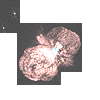 Recently stars have been
discovered that are called hypergiants, e.g. Eta Carinae, (c) AURA / STScI ,
which at 100 sun masses weighs in as the heaviest star known in our
galaxy. In 1842 and 1843 it had a major outburst that made it the
brightest star in the sky for several years. The shed dust and gas of
this super wind was imaged by Hubble. Since it is so massive, it has
such a short lifetime that it can go supernova any time soon (in the next thousands of years). Let's talk about
case 2 first.
Recently stars have been
discovered that are called hypergiants, e.g. Eta Carinae, (c) AURA / STScI ,
which at 100 sun masses weighs in as the heaviest star known in our
galaxy. In 1842 and 1843 it had a major outburst that made it the
brightest star in the sky for several years. The shed dust and gas of
this super wind was imaged by Hubble. Since it is so massive, it has
such a short lifetime that it can go supernova any time soon (in the next thousands of years). Let's talk about
case 2 first.
(Arny ch.14) The atmosphere is blown off and it remains the star's core, whose mass is only a fraction of the star's original mass.
Mass of left-over core
< 1.4 sun masses _________________
between 1.4 and 3.0 sun masses _________________
> 3.0 sun masses _________________
, so the original mass may be responsible for possibilities of carbon, oxygen fusing, etc., evolutionary track, the way of death ... But it's the mass of the remaining core that determines the star's coffin.
Well, we had White Dwarfs and Neutron Stars.
A star left with more than 3.0 sun masses after the supernova will collapse further because even the tightly packed neutrons can't stand gravity.
Gravity pulls everything inside, the star collapses totally under its weight and becomes a
 This black hole candidate
turned out not be one, but instead a triple star, (c) AURA / STScI . Actually,
the "e" at the end of Black hole is much
too large, in fact infinitely too large. Yet it contains more than 3
sun
masses. Some Black Holes, which are also believed to originate as the
cores
of Galaxies, contain many millions of sun masses in a point smaller
than
the above "e".
This black hole candidate
turned out not be one, but instead a triple star, (c) AURA / STScI . Actually,
the "e" at the end of Black hole is much
too large, in fact infinitely too large. Yet it contains more than 3
sun
masses. Some Black Holes, which are also believed to originate as the
cores
of Galaxies, contain many millions of sun masses in a point smaller
than
the above "e".
It does not have a definite radius (well, its radius is zero). Yet there is a defined distance from the black hole's singularity. It is called the Schwarzschild radius or event horizon.
Event horizon (about 9 km for a black hole of 3 sun masses): Gravity is so strong inside the event horizon that nothing, not even light, can escape. Seen from the outside, a space traveller approaching the black hole would seem to take forever to fall in (time dilation as predicted by general relativity). Matter that is very close to the black hole can be sucked into the black hole, it accelerates and gives off x-rays. Confused? That's good.
In the hypothetical case that our Sun would (magically) become a
one solar mass black hole, what would happen to Earth in its
orbit? (Why can the Sun not become a black hole?)
Among these effects the theory of a moon coming to close to Saturn, being ripped apart and forming the rings, is important for the following.
Go to (Arny p.417; Ch/Mc p.348, Fig. 15.2) .
One topic, that we left out, are binary stars. Two stars of any mass orbit each other. Which one dies first? _________________
Say, one of them ends up with less 1.4 sun mass after its Red Giant phase. It becomes a _________________ . Also assume that they're pretty close - maybe Earth-Sun distance.
Eventually, the other star starts dying too and becomes a Red
Giant.
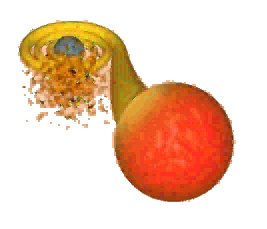 |
Red Giant and White Dwarf orbiting each
other. Accretion of mass by the white dwarf. Violent
ignition of hydrogen on the wd's surface. (c) Redshift 3.
Now, parts of the atmosphere of the red giant may expand so far (beyond its own Roche lobe) that they experience more gravitational force from the white dwarf than from their own star. What happens? ... Correct. The transferred mass is accreted by the white dwarf and circulates it. More and more mass is thrown onto the white dwarf. This gas, mostly hydrogen, on the white dwarf's surface becomes hotter and hotter. |
 Nova Cygni 1992,(c)
AURA / STScI . Eventually ...
Nova Cygni 1992,(c)
AURA / STScI . Eventually ...
What happens to the white dwarf's brightness? ...
It goes ...
 Blobs in Space: The Legacy of a Nova, (c) AURA / STScI .
The star brightens by a factor of 10,000 for several weeks until
hydrogen fusion __________ .
Blobs in Space: The Legacy of a Nova, (c) AURA / STScI .
The star brightens by a factor of 10,000 for several weeks until
hydrogen fusion __________ .
The remaining Helium and Hydrogen just sits on the white
dwarf's surface until enough matter from the red giant is accreted to
ignite hydrogen again (can take several thousands
years).
That's the basic theory of a Nova.
There are a couple of twists associated with mass accretion.
One is that binary stars are observed where the white dwarf is
less massive than its main sequence companion. It seems that
the lighter star died first. What's the correct theory for
this phenomenon? ...
(Arny p.418) The other is: What could happen to a white dwarf if it accretes so much mass that it crosses the limit of 1.4 sun masses? ...
Check out the spectra of Nova Sgr 2001 .
- What's the cause of Northern Lights?
- What are conservation laws?
We used one of the latter, in particular conservation of energy. E.g. the energy radiated from a star equals the energy produced in the star.
Now we'll use the conservation of Angular Momentum.
Imagine that you and some other people are sitting on the edge of a merry-go-around. Then the other people crawl into the center. What happens to you? ...
That's because Angular Momentum L is conserved. L = m r² w = const. Here m is everybody's mass (which remains constant), r the distance from people to the center, which becomes smaller. Consequently, since L is conserved, the angular velocity w must increase.
 Crab Nebula, at its center lies a Pulsar, (c) AURA / STScI. As a star shrinks from its
main sequence size to the "Manhattan" size of a Neutron star (r becomes smaller) , its angular velocity must
increase, since angular momentum is constant. It rotates faster. In
fact, our sun needs about 25-29 days to rotate. A neutron star, being
much smaller, rotates much faster, a millisecond to about
5 sec for some neutron stars.
Crab Nebula, at its center lies a Pulsar, (c) AURA / STScI. As a star shrinks from its
main sequence size to the "Manhattan" size of a Neutron star (r becomes smaller) , its angular velocity must
increase, since angular momentum is constant. It rotates faster. In
fact, our sun needs about 25-29 days to rotate. A neutron star, being
much smaller, rotates much faster, a millisecond to about
5 sec for some neutron stars.
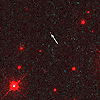 Hubble Sees a Neutron Star Alone in Space, (c) AURA / STScI .
Furthermore, the neutron star's magnetic field is conserved. Now
that the neutron star is very small, the magnetic field close to its
surface is very large.
Hubble Sees a Neutron Star Alone in Space, (c) AURA / STScI .
Furthermore, the neutron star's magnetic field is conserved. Now
that the neutron star is very small, the magnetic field close to its
surface is very large.
What does this have to do with the Northern lights?
As in the Earth's case, electric charges (for Earth
from Sun, for neutron star from Interstellar Medium) are
captured
by the magnetic field and spiral around the magnetic field lines onto
the
magnetic poles. Being accelerated, these electric charges radiate
radiowaves,
which extend from the magnetic axis.
Every time one of the pulsar's magnetic poles faces the Earth (within seconds or fractions of a second), we can
register radiowaves from this "lighthouse beacon". (Visible
light and x-rays are detected to a lesser degree.)
If the mass of the remaining core exceeds 3 Mo
, the neutrons' pressure can't balance gravity
-> collapse of the star to a point like object (singularity) with
infinite density follows.
The theory is worked out well, the most likely candidate for a
Black Hole is Cygnus X-1 (Einstein's general
relativity applies) . Check the Sky & Telescope May
1996 issue for more candidates.
Furthermore, cores of galaxies (e.g. our own Milky Way)
are believed to be made up of supermassive black holes
(several million M in a singularity).
Properties:
- singularity, i.e. point like object with M > 3 sun masses and infinite density
- no definite surface
- Schwarzschild radius = 3 [km]
-> event horizon (same as Schwarzschild radius)
would be at 9 km = 6 miles around a point containing 3 sun masses
- event horizon -> everything falling inside, is never seen again, even light can't escape
- matter, prior to falling in, is greatly accelerated ->
x-rays send out in huge amounts
(Clue: strong x-rays observed from Cygnus X-1, which
orbits HDE 226868)
- mass so great that light from farther object is bent by
Black
Hole
-> gravitational lens producing two or smeared out ring like images
of farther object
AAVSO - American Association
of
Variable Star Observers
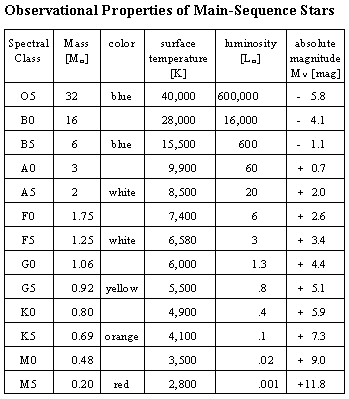 |
TABLE 1 |
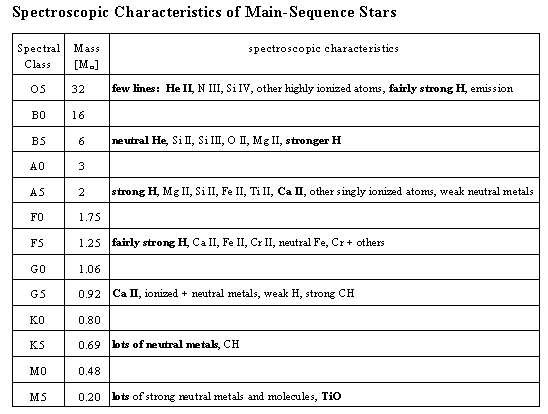 |
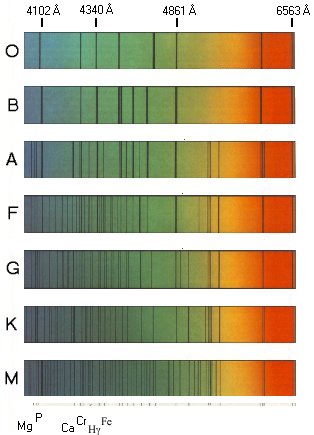 |
more spectral sequence web sites:
http://home.achilles.net/~jtalbot/data/plots.html ,
spectral sequence .
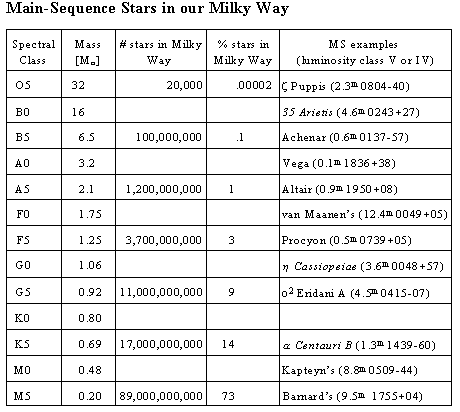 TABLE 3
TABLE 3
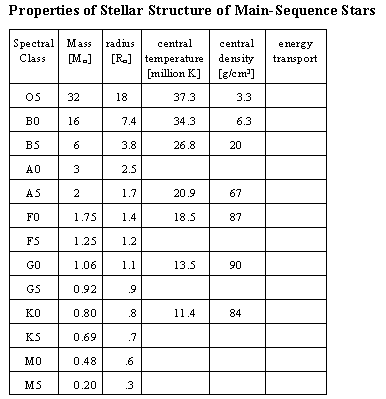 TABLE 4
TABLE 4
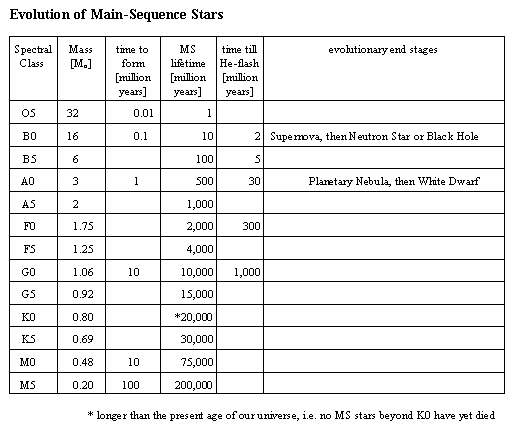 TABLE 5
TABLE 5
Table 6, More Observational Properties
of Main Sequence Stars
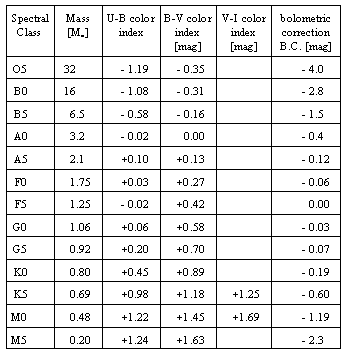 TABLE 6
TABLE 6
The following table shows solar system abundances for some
elements. From the Periodic System of
the Elements , 89 elements occur naturally. Since our Sun
contains about 99.8% of the solar system's mass, these numbers are
valid for our Sun's composition as well. And all other stars have
similar abundances. A common misconception is though that a
casual look at spectral absorption lines (spectral classes) gives us
the stars' compositions. It doesn't. Instead that casual
look gives us the surface temperature. But check my lecture on Measuring Stars on how a star's
composition really is determined by looking very carefully at the
absorption lines.
| Element | Abundance | ............. | Element | Abundance | ||||
| 1 | H | Hydrogen | 1,000,000,000,000 | 26 | Fe | Iron | 32,000,000 | |
| 2 | He | Helium | 98,000,000,000 | 27 | Co | Cobalt | 81,000 | |
| 3 | Li | Lithium | 15 | 28 | Ni | Nickel | 1,800,000 | |
| 4 | Be | Beryllium | 14 | 29 | Cu | Copper | 19,000 | |
| 5 | B | Boron | 400 | ... | ||||
| 6 | C | Carbon | 350,000,000 | 79 | Au | Gold | 7 | |
| 7 | N | Nitrogen | 93,000,000 | 80 | Hg | Mercury | 12 | |
| 8 | O | Oxygen | 740,000,000 | 81 | Tl | Thallium | 7 | |
| 9 | F | Fluorine | 36,000 | 82 | Pb | Lead | 110 | |
| 10 | Ne | Neon | 120,000,000 | ... | ||||
| 11 | Na | Sodium | 2,000,000 | 90 | Th | Thorium | 1 | |
| 12 | Mg | Magnesium | 38,000,000 | 91 | Pa | Protactinium | - | |
| 13 | Al | Aluminum | 3,000,000 | 92 | U | Uranium | .3 | |
| 14 | Si | Silicon | 35,000,000 | |||||
| 15 | P | Phosphorus | 370,000 | |||||
| 16 | S | Sulfur | 19,000,000 | |||||
| 17 | Cl | Chlorine | 190,000 | |||||
| 18 | Ar | Argon | 1,000,000 | |||||
| 19 | K | Potassium | 130,000 | |||||
| 20 | Ca | Calcium |
2,200,000
|
References:
Material created with support to AURA / ST ScI from NASA contract NAS5-26555 is reproduced here with permission.
Measuring Stars Lecture
* Atmosphere of Betelgeuse; courtesy of A. Dupree (CfA)
and NASA
* Hubble Separates Stars In The Mira Binary System;
courtesy of Margarita Karovska (Harvard-Smithsonian Center for
Astrophysics) and NASA
* Hubble Catches Up with a Blue Straggler Star;
courtesy of R. Saffer (Villanova University), D. Zurek (ST ScI) and NASA
* Star Birth in NGC 1850; courtesy of Ray Villard, Nino
Panagia (STScI) and NASA
* Dense Globular Cluster M15; courtesy of Robert Irion
(Univ. CA, Santa Cruz), Barbara Kennedy (Pennsylvania State Univ.), Ray
Villard (STScI) and NASA
Favorite Hubble Images Lecture
* Release of Hubble Space Telescope; courtesy of Space
Shuttle Endeavor STS-61 crew and NASA
* The Orion Trapezium and their (artificial)
Airy-disks; courtesy of John Bally, Dave Devine, and Ralph Sutherland
(CITA) and NASA
* Comet P/Shoemaker-Levy 9 (1993e); courtesy of Hal
Weaver, T. Ed Smith (STScI) and NASA
* Comet Shoemaker-Levy 9 impact sites on Jupiter;
courtesy of Hubble Space Telescope Comet Team and NASA
* Aurora on Saturn; courtesy of J.T. Trauger (Jet
Propulsion Laboratory) and NASA
* Pluto and Charon - before adjustment of focus;
courtesy of ESA and NASA
* Pluto and Charon - after adjustment; courtesy of R.
Albrecht (ESA/ESO), Keith S. Noll (STScI) and NASA
* Star Birth in M16 Eagle Nebula;
courtesy of Jeff Hester, Paul Scowen (Arizona State University) and NASA
* Proplyds in Orion Nebula; courtesy of John Bally,
Dave Devine, and Ralph Sutherland (CITA) and NASA
* Destruction of Proto-Planetary Disks in Orion's
Trapezium Explained; courtesy of John Bally, Dave Devine, and Ralph
Sutherland (CITA) and NASA
* Final Blaze Of Glory Of Sun-Like Stars, the Butterfly
Nebula; courtesy of Bruce Balick (University of Washington), Vincent
Icke (Leiden University, The Netherlands), Garrelt Mellema (Stockholm
University), and NASA
* Helix Nebula; courtesy of C. Robert O'Dell, Kerry P.
Handron (Rice University) and NASA
* Stingray Nebula; courtesy of M.
Bobrowsky (Orbital Sciences Corp.) and NASA
* Egg Nebula; courtesy of R. Sahai and J. Trauger
(JPL), the WFPC2 Science Team and NASA
* NICMOS Peers Into Heart Of Dying Star; courtesy of
Rodger Thompson, Marcia Rieke, Glenn Schneider, Dean Hines
(University of Arizona), Raghvendra Sahai (Jet Propulsion Laboratory),
NICMOS
Instrument Definition Team and NASA
* Hourglass Nebula; courtesy of R. Sahai, J. Trauger
(JPL), the WFPC2 Science Team and NASA
* Cat eye Nebula; courtesy of J.P. Harrington, K.J.
Borkowski (University of Maryland) and NASA
* Doomed Star Eta Carinae; courtesy of Jon Morse
(University of Colorado) and NASA
* Supernova Blast Begins Taking Shape; courtesy of Chun
Shing Jason Pun (NASA/GSFC), Robert P. Kirshner (Harvard-Smithsonian
Center for Astrophysics) and NASA
* Cygnus Loop; courtesy of Jeff Hester (Arizona State
University) and NASA
* Oxygen-Rich Supernova Remnant in the Large Magellanic
Cloud; courtesy of J. Morse (ST ScI) and NASA
* Cartwheel Galaxy; courtesy of Kirk Borne (ST ScI) and
NASA
* Galactic Building Blocks; courtesy of Rogier
Windhorst, Sam Pascarelle (Arizona State University) and NASA
* Hubble Astronomers Use Lens In Nature To Uncover Most
Distant Galaxy In The Universe; courtesy of Marijn Franx (University of
Groningen, The Netherlands), Garth Illingworth (University of
California, Santa Cruz) and NASA
* Gravitational Lens in Cluster Cl0024+1654; courtesy
of W.N. Colley and E. Turner (Princeton University), J.A. Tyson (Bell
Labs, Lucent Technologies) and NASA
* Hubble Deep Field; courtesy of R. Williams and the
HDF Team (ST ScI) and NASA
* Black Hole in the galaxy NGC 4261; courtesy of H.
Ford and L. Ferrarese (JHU) and NASA
Stellar Evolution Lecture
* Orion Nebula Mosaic; courtesy of C.R. O'Dell, S.K.
Wong (Rice Univ.) and NASA
* Giant Starbirth Region In Neighboring Galaxy;
courtesy of Hui Yang (University of Illinois) and NASA
* "Proplyds'' in Orion Nebula; courtesy of C.R. O'Dell
(Rice Univ.) and NASA
* Inside Red Dwarfs (Gl752b); courtesy of Ray Villard
(STScI), Jeffrey Linsky (JILA) and NASA
* Brown Dwarf Gliese 229B; courtesy of T. Nakajima and
S. Kulkarni (Caltech), S. Durrance and D.Golimowski (JHU) and NASA
* Small Star (Gl623b); courtesy of C. Barbieri (Univ.
of Padua) and NASA
* White Dwarf Stars in Globular Cluster M4; courtesy of
Harvey Richer (University of British Columbia, Vancouver, Canada) and
NASA
* Supernova in Galaxy M51; courtesy of Robert P.
Kirshner (Harvard-Smithsonian Center for Astrophysics) and
NASA
* Supernova 1987A Rings; courtesy
of Christopher Burrows (ESA/STScI) and NASA
* Crab Nebula; courtesy of Jeff Hester and Paul Scowen
(Arizona State University) and NASA
* Black Hole Candidate: Victim of
Misatken Identity; courtesy of Right -- Wachter et. al. (University of
Washington) and NASA, Left -- Paul Schmidtke (Arizona State University)
and Cerro Tololo Interamerican Observatory, Chile
* Nova Cygni 1992; courtesy of F.
Paresce, R. Jedrzejewski (STScI) and NASA
* Blobs in Space: The Legacy of a
Nova; courtesy of Mike Shara, Bob Williams, and David Zurek (Space
Telescope Science Institute), Roberto Gilmozzi (European Southern
Observatory), Dina Prialnik (Tel Aviv University) and NASA
* Hubble Sees a Neutron Star Alone in Space; courtesy
of Fred Walter (State University of New York at Stony Brook) and NASA